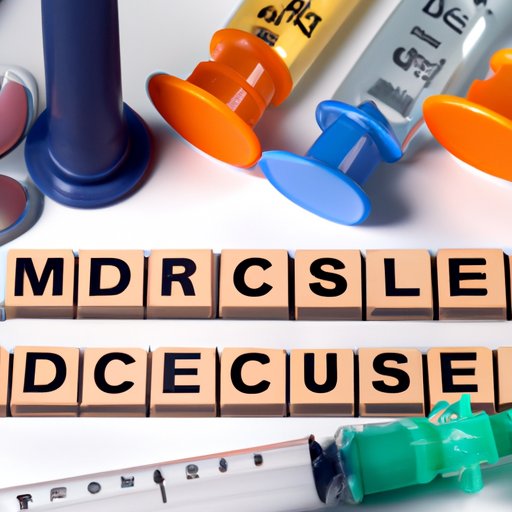Introduction
Duchenne Muscular Dystrophy, or DMD, is a genetic disorder that affects primarily boys and leads to a progressive weakening of muscles. It’s a rare and devastating condition, affecting between 1 in 3,500 to 1 in 5,000 boys worldwide. Sadly, there is no cure for DMD, but with early diagnosis, interventions, and a supportive community, individuals with this condition can lead a full and meaningful life. This article aims to provide helpful insights and support for those who are navigating the world of Duchenne Muscular Dystrophy.
What You Need to Know About DMD: Understanding the Basics of Duchenne Muscular Dystrophy
DMD is caused by mutations in the dystrophin gene, which encodes for a protein that helps to maintain muscle integrity. With a deficiency in dystrophin, muscles become susceptible to damage, leading to muscle wasting. This typically leads to difficulty with movements, such as walking, running, and climbing stairs.
Symptoms of the condition tend to emerge between the ages of 3 to 5, and can include frequent falls, difficulty getting up from the ground, and muscle weakness. As DMD progresses, individuals may also experience respiratory and cardiac issues.
There are four stages of DMD progression: the early ambulatory phase, when the child is still able to walk independently; the late ambulatory phase, when mobility is compromised; the non-ambulatory phase, which sees complete loss of walking ability; and the phase of advanced DMD, which can involve severe respiratory and cardiac issues.
While there is no cure for DMD, early intervention and management can help in delaying muscle deterioration and complications. Treatment options include physical therapy, medications, and surgery.
Living with DMD: A Personal Account of Coping with Duchenne Muscular Dystrophy
Living with DMD can be challenging, both physically and emotionally. Practical tasks such as mobility, self-care, and accessing educational and social opportunities can require significant effort and creativity. Emotional struggles such as dealing with loss of mobility and independence, managing pain, and facing unexpected challenges can be overwhelming and draining.
A young boy named James was diagnosed with DMD when he was just four years old. Even though the diagnosis was devastating for his family, they have learned to adapt to the challenges that come with the condition. James, now ten years old, uses a wheelchair and requires assistance for most daily activities. Despite these challenges, James loves spending time with his siblings, reading books, listening to music, and playing on his iPad. Thanks to the support of his family and the community, James has been able to lead a happy and fulfilling life.
The Latest Advances in DMD Research: Potential Breakthroughs in Treating Duchenne Muscular Dystrophy
There are numerous research efforts underway to find new ways to treat DMD. One promising avenue is gene therapy, which involves delivering a healthy copy of the dystrophin gene to patients with DMD. Another approach involves the development of exon skipping drugs that can help to bypass the damaged or missing parts of the dystrophin gene. Various other drugs, including anti-inflammatory drugs and immune suppressants, are also being developed to help manage symptoms and complications of the condition.
While progress has been made, much work still needs to be done. Funding for research can be a challenge, and many people with DMD struggle to access these treatments. Despite these challenges, the DMD community is hopeful that these new therapies will result in a better quality of life for those with DMD.
Supporting Loved Ones with DMD: A Guide to Helping Caregivers of Those Diagnosed with Duchenne Muscular Dystrophy
Caring for someone with DMD can be emotionally and physically demanding. Caregivers play an important role in supporting their loved ones, from helping with daily tasks such as bathing and dressing to advocating for their needs and ensuring access to appropriate accommodations.
It’s essential for caregivers to take care of themselves too, including seeking out support from other caregivers, accessing mental health services, and finding ways to cope with the demands of caring for someone with DMD. Online support groups, social media platforms, and local support organizations can be excellent resources.
Breaking the Stigma Surrounding DMD: Misconceptions and Realities About Duchenne Muscular Dystrophy
There are numerous misconceptions and stereotypes about DMD that can make it difficult for individuals with the condition and their families. Some of these misconceptions include the belief that people with DMD are intellectually disabled, always confined to a wheelchair, or unable to participate in sports or leisure activities.
In reality, people with DMD are intelligent, creative, and ambitious individuals who can lead rich and fulfilling lives. They require accommodations, support, and some adaptations to enable them to engage in their desired activities. Breaking down myths and replacing them with accurate information can help create a more inclusive and supportive community.
Conclusion
DMD is a complex and challenging condition that affects individuals and their families in many ways. While progress has been made in understanding the condition and developing treatments, there is still much work to be done. Early diagnosis, interventions, and access to support and resources are critical in helping individuals with DMD reach their full potential. We hope that this article provides a helpful overview and support for those who are navigating life with DMD.
